Strapped on my bike and drove down to Columbia for the day on Saturday to see Daniel, Jennifer, Ellen, and Arianna. The highlight of the day was a several-hour bike adventure on the wonderful bike/walking trail that runs between the Broad River and the 19th century canal that was built to bypass the rapids (the "fall line") in the river for the sake of commerce and transportation. One of the historical markers we read said that, in that era, towns developed at spots on rivers where rapids prevented commerce further upriver -- to wit, Columbia. But the canal was eventually built and commerce moved on. Once the railroads began shouldering the majority of commerce the canal ceased to be used for transportation and shipping. But it remains a beautiful and tranquil setting -- several miles of wildlife and peaceful water. Rapids in the river on one side of the bike trail, a tabletop-smooth canal on the other.
Jen took the afternoon to get things done at the house, so it was Daniel, the girls, and me on our four bikes (no training wheels in sight!). Ellen and Arianna are troopers. Two-plus hours in the blazing sun, a four-mile bike ride, a few scary descents from the trail into the cool, dark forest between the river and canal -- all with no complaining. They are thoroughly enjoyable companions who are as eager to learn as their parents are to teach.
In the parking area before biking up:
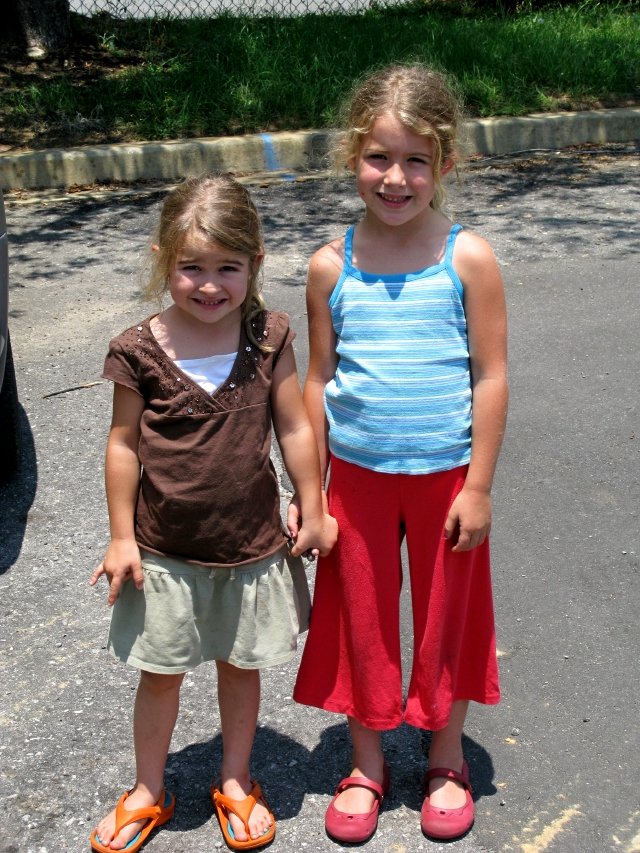

In the late 19th century, a hydro-electric facility was built and water from the canal was diverted through it to provide electricity for Columbia. This is very near downtown Columbia -- history on display:
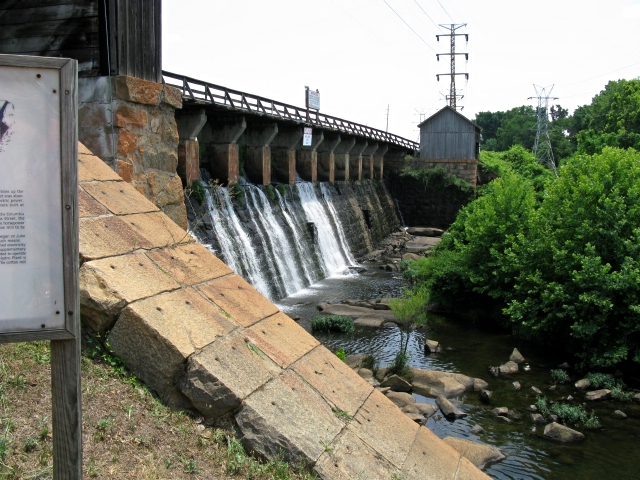
A very nice observation facility has been constructed at the site of the hydro facility -- very impressive:
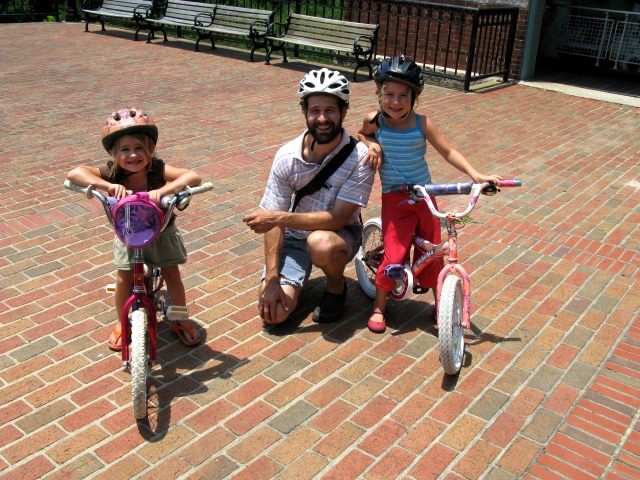
A couple of miles upstream on the bike path you reach this concrete dam built across the Broad River. I never quite understood the purpose or history of this dam -- but the water flowing through the gap in the dam creates significant swift water. The river bed below this dam is filled with granite boulders -- "the basement of the Appalachians," one of the markers said -- and rapids. Very impressive -- had no idea Columbia, SC, had this kind of aquatic dynamics:

Beautiful egrets (white) and herons (dark gray) stand like statues on rocks in the rapids waiting to grab lunch. Ellen and I named the egret "Ellen Egret" and the heron "Henry Heron:"
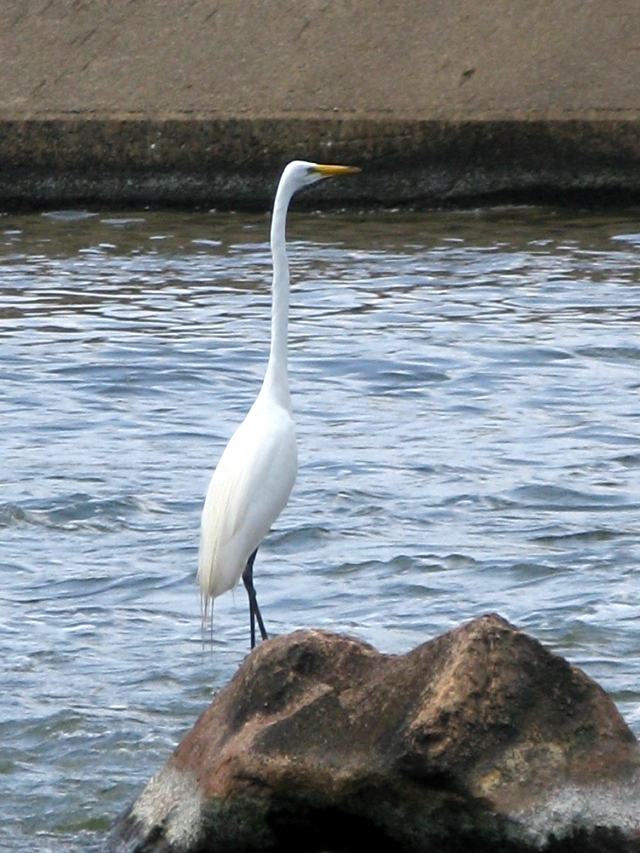

Daniel demonstrated that it is possible to float in six inches of swift water. (He was actually just cooling off -- can't say that I blamed him.)
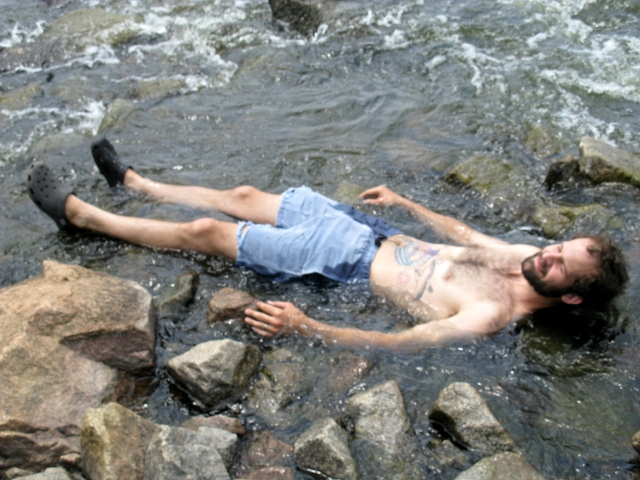
All the following pix were taken at the site of the dam where we paused to rest and cool off -- and in the cool woods bordering the Broad River:
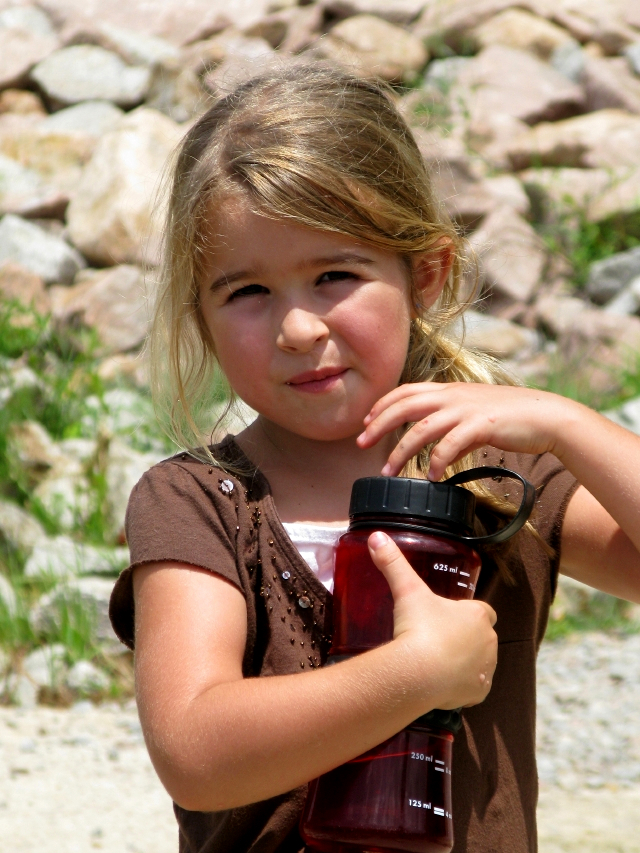
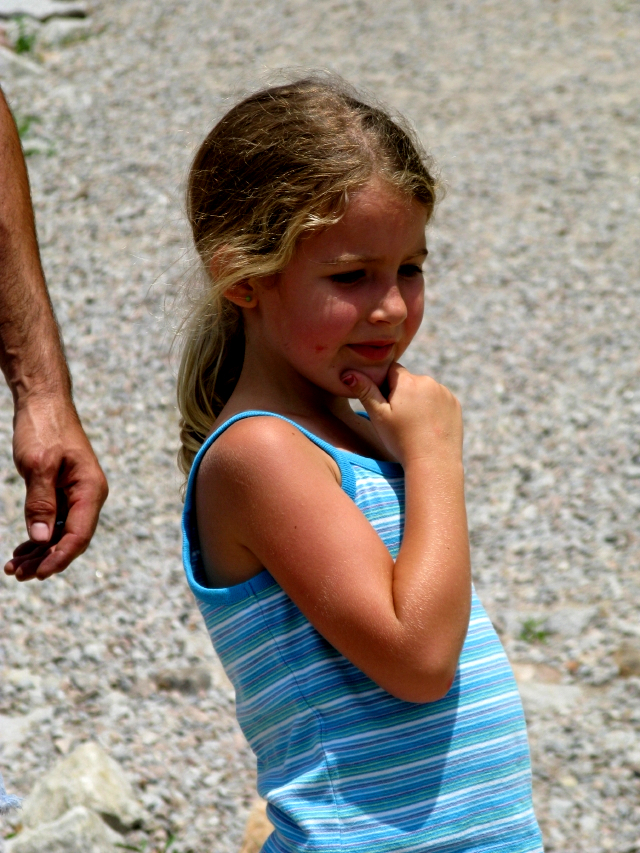
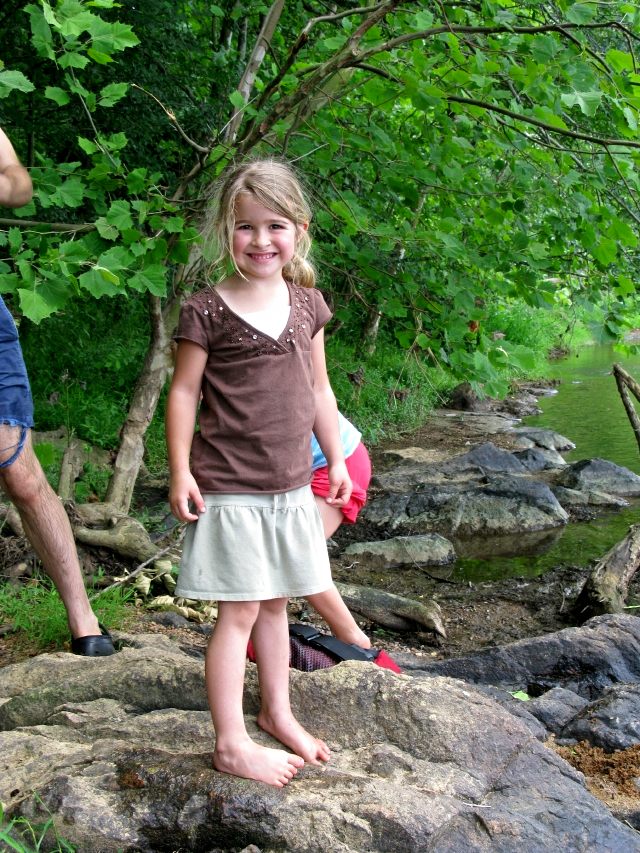

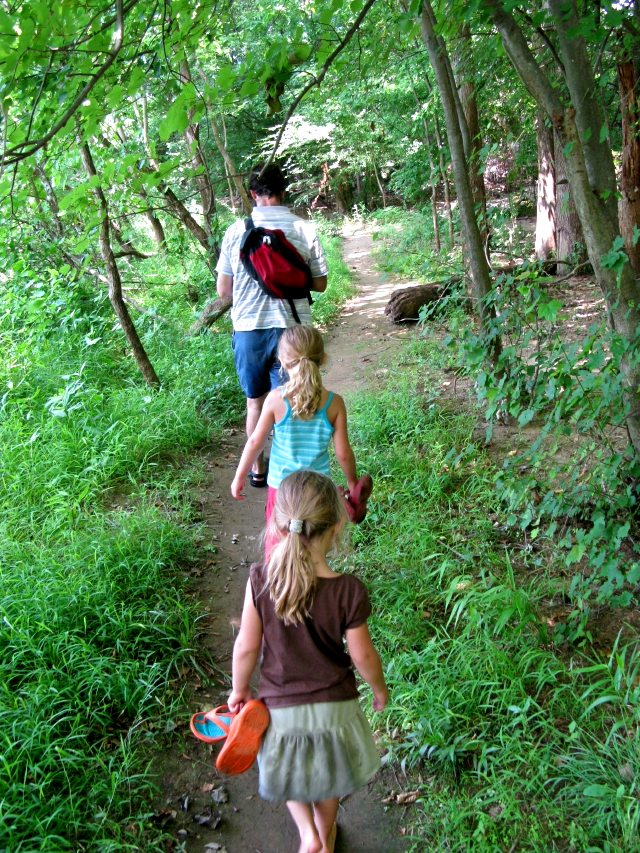
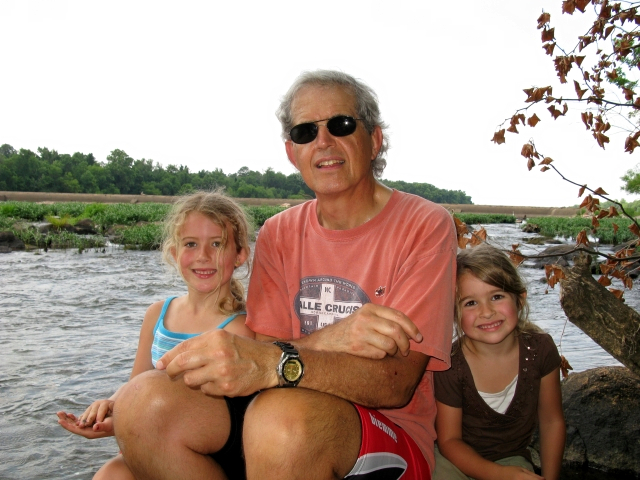

Here we're riding along the bike path on the way back to the parking area. You can see the beautiful canal on the left, while the river runs parallel to it on the other side of the trees on the right:

We stopped a couple of times along the way to look at wildlife: a huge turtle sunning on a log in the middle of the canal and another "Henry Herron" standing motionless in the grass waiting, again, for lunch:

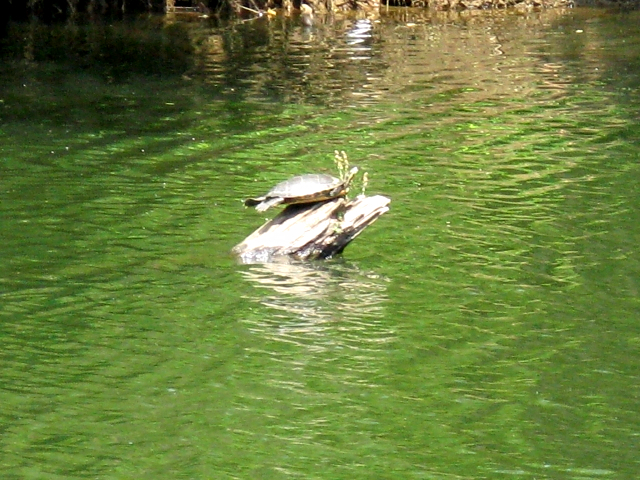
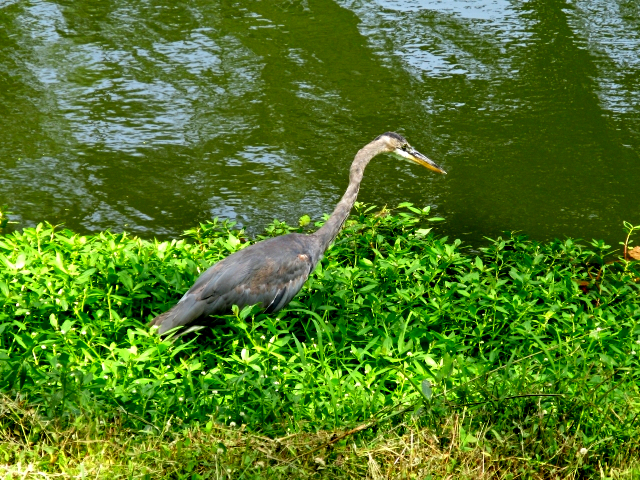
At one point, Ellen and I were riding behind Daniel and Arianna. Somehow, she spied these two little purple flowers growing just off the edge of the bike path. Look closely -- they're right in the middle of the picture:
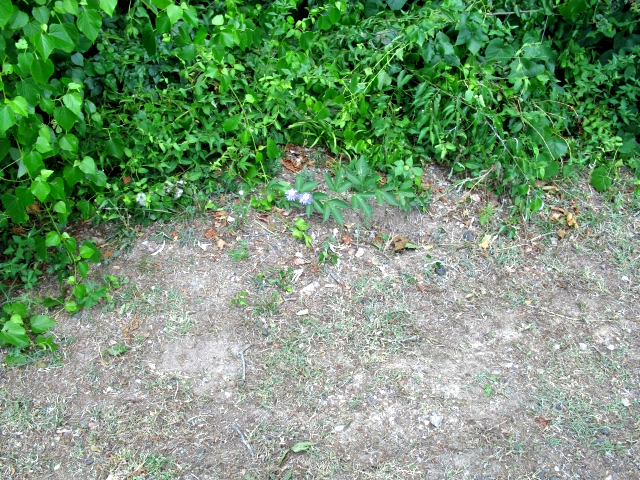
Of course, we had to stop and get a picture of these amazingly intricate flowers and their three-pronged leaves. Daniel wasn't familiar with them -- we assumed they were just some kind of wildflower. But when we got home and were looking through another garden book on fruit-bearing trees and plants we saw the very same purple flowers and three-pronged leaves in the book. Turns out the plant is called Maypop (passiflora incarnata). Here is a short excerpt from the Wikipedia article:
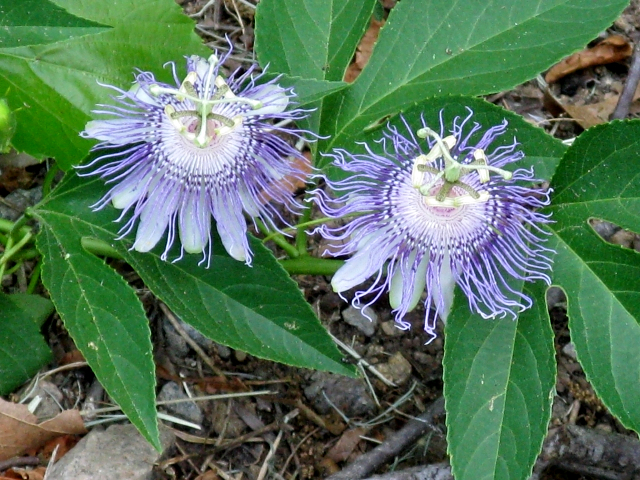
Because Daniel and Jen are learning to "root" various plants, I have a feeling they'll be back out there soon to get a cutting off the Maypop vine to try to root and plant in their yard.
The bike ride was a delightful excursion -- hats off to Columbia, SC, for its provision of the trail as well as the amenities, historical markers, and such that make it an inviting setting to explore. And kudos to Daniel and the girls for the pleasure of their company.
Earlier in the day we were checking out Daniel and Jen's garden while Daniel lamented the scourge of the squash vine borer that has been wreaking havoc on their squash plants. The squash vine borer is the larva that hatches from a tiny reddish egg laid by a uniquely-colored and shaped moth that flies around looking for members of the cucurbit family (melon, pumpkin, squash, cucumbers, gourds) on which to lay one egg at a time. In the south, they rarely afflict cukes, but wreak havoc on squash. The tiny egg is usually laid at the base of the squash plant where it hatches a larvae that bores into the trunk of the squash plant and proceeds to kill the plant by eating the nutrient-carrying inner parts of the trunks and stems. After a couple of weeks of this the larva emerges, burrows into the ground beneath the plant, and remains in cocoon form until it pupates into the above-mentioned moth which starts the life cycle all over again. Some regions of the country have just one life-cycle per season, but two cycles per season are common in the South: one in June and another in later summer.
It so happens that while we were standing in the garden talking one of the moths flew by! I recognized it immediately from my prior experience with them as did Daniel. It got away but reappeared a few minutes later and he swung it at with his hand, knocking it to the ground. No gardener can eliminate all the vine borer moths -- but Daniel eliminated this one. They are "sort of" wasp-shaped -- not like a traditional moth -- with distinctive black and red coloring. This is the top side (the back and wings):
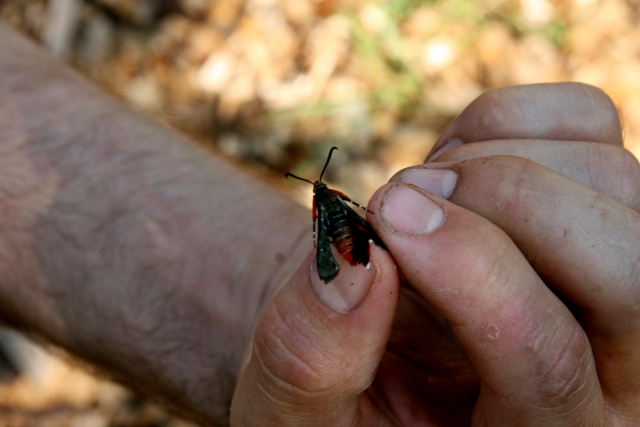
And this is the underside:
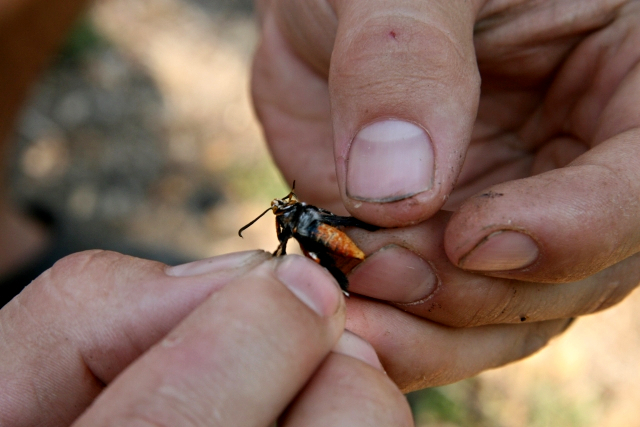
Here's the trunk of a squash plant. If you look closely on the white part of the trunk, about 2-3 inches from where the trunk enters the ground (just to the right of a small leaf-looking protrusion), you'll see a tiny reddish dot. That's an egg -- probably laid by the very vine borer moth dispatched by Daniel:
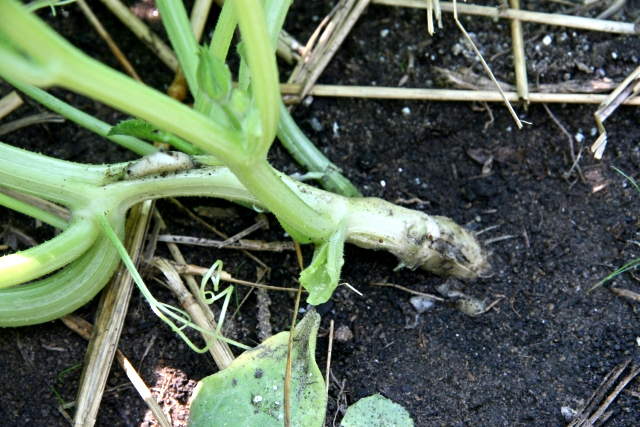
Here's a cropped close-up of the egg (middle of the photo):
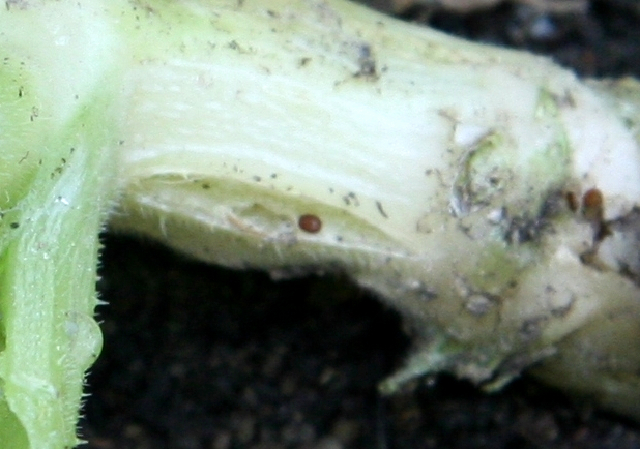
Nobody said gardening was easy. One market gardener I know said the solution is to plant enough squash for you and the vine borers. But when you only have a few plants it becomes a challenge to save every one.
Here are a few more photos from the day:
The lovely Jen:
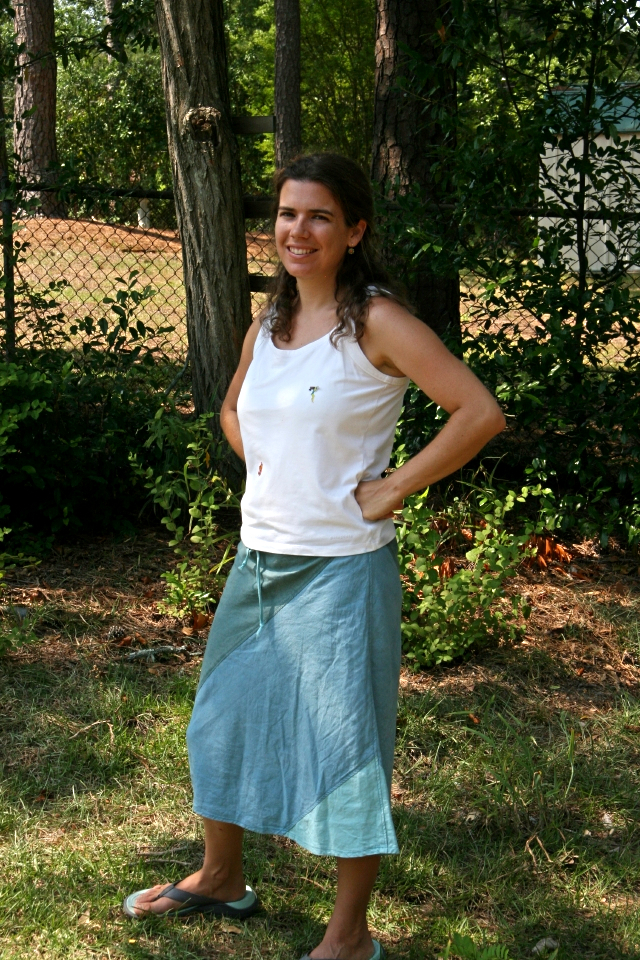
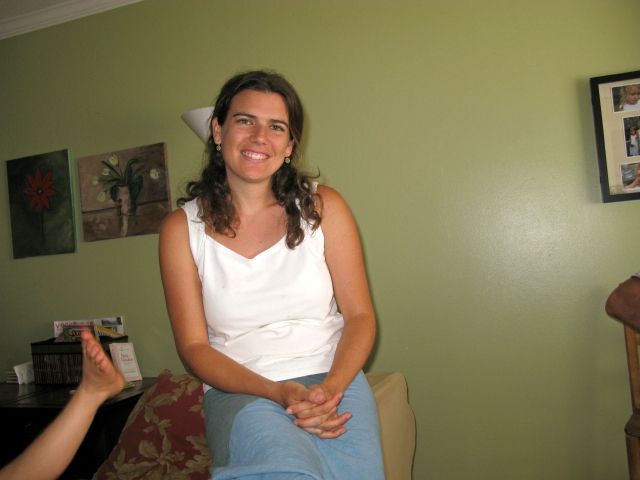
Daddy and daughter:
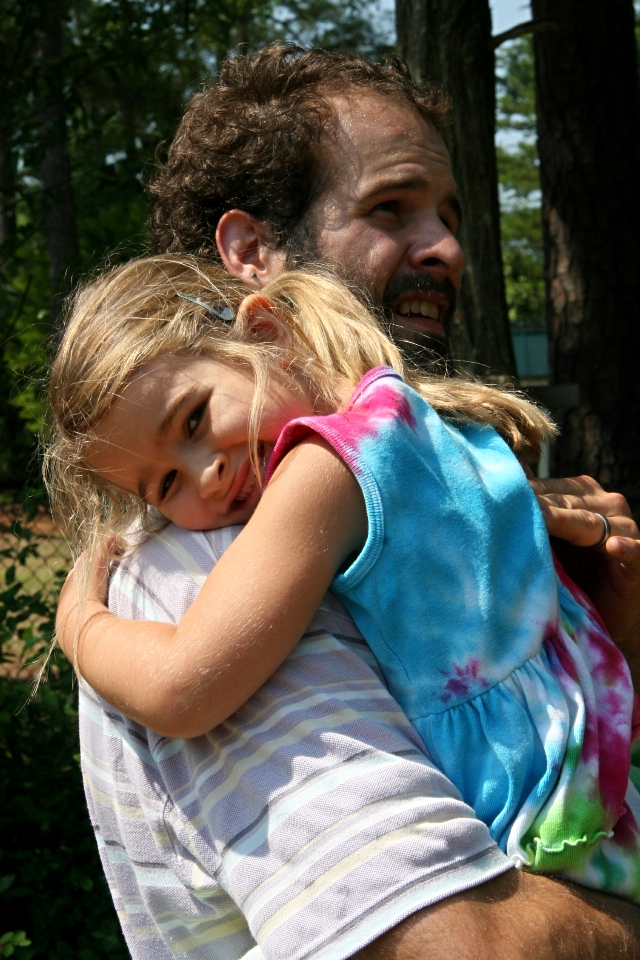
Two acoustic wannabe's:
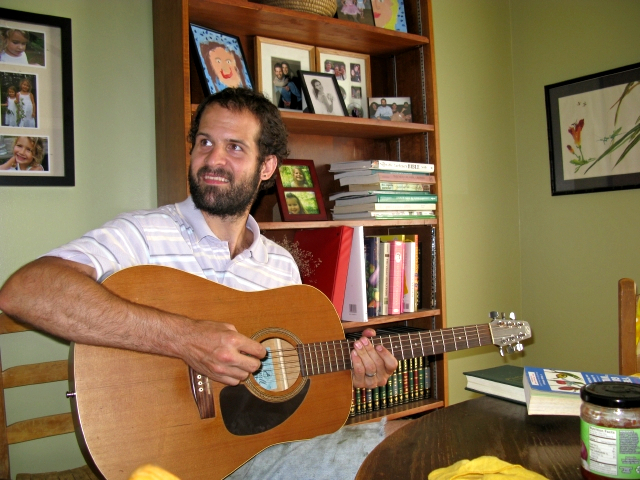
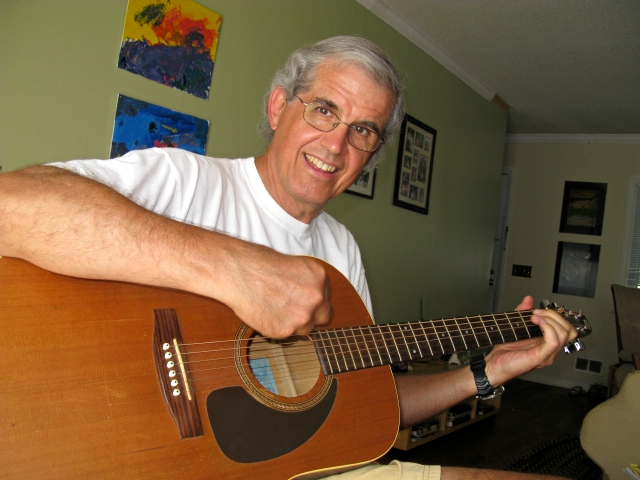
Two of a million pictures Arianna took with my camera:

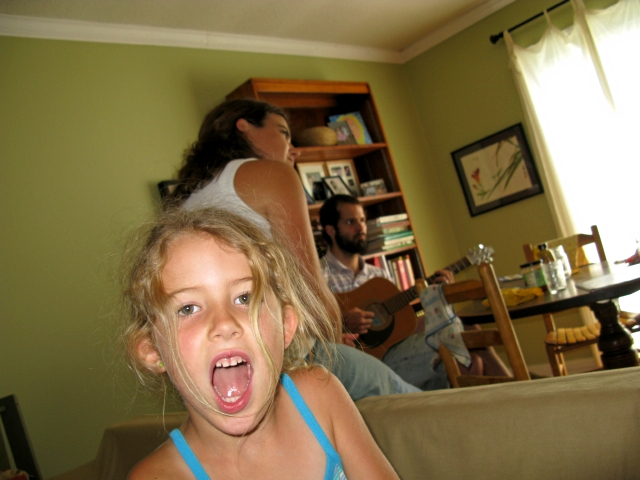
And some face-painting before going out to eat for veggie burritos and a free music concert in a local park. (Grandad passed on the concert to motor home before it got too late.)
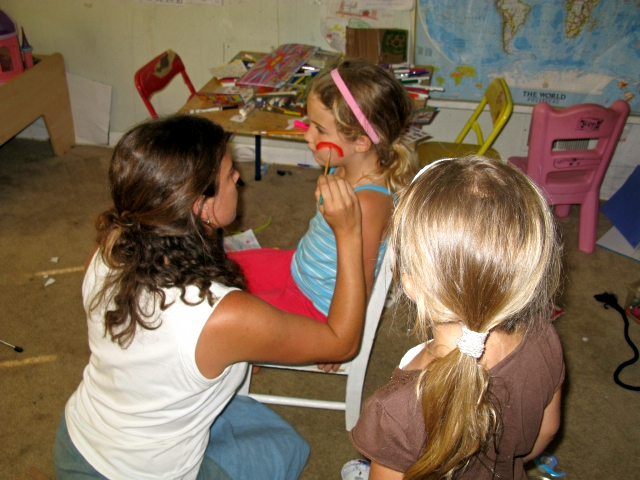
Nice day in Columbia -- thanks to the Columbia Kruideniers for hosting a Charlotte Kruidenier for the day.
Jen took the afternoon to get things done at the house, so it was Daniel, the girls, and me on our four bikes (no training wheels in sight!). Ellen and Arianna are troopers. Two-plus hours in the blazing sun, a four-mile bike ride, a few scary descents from the trail into the cool, dark forest between the river and canal -- all with no complaining. They are thoroughly enjoyable companions who are as eager to learn as their parents are to teach.
In the parking area before biking up:


In the late 19th century, a hydro-electric facility was built and water from the canal was diverted through it to provide electricity for Columbia. This is very near downtown Columbia -- history on display:

A very nice observation facility has been constructed at the site of the hydro facility -- very impressive:

A couple of miles upstream on the bike path you reach this concrete dam built across the Broad River. I never quite understood the purpose or history of this dam -- but the water flowing through the gap in the dam creates significant swift water. The river bed below this dam is filled with granite boulders -- "the basement of the Appalachians," one of the markers said -- and rapids. Very impressive -- had no idea Columbia, SC, had this kind of aquatic dynamics:

Beautiful egrets (white) and herons (dark gray) stand like statues on rocks in the rapids waiting to grab lunch. Ellen and I named the egret "Ellen Egret" and the heron "Henry Heron:"


Daniel demonstrated that it is possible to float in six inches of swift water. (He was actually just cooling off -- can't say that I blamed him.)

All the following pix were taken at the site of the dam where we paused to rest and cool off -- and in the cool woods bordering the Broad River:







Here we're riding along the bike path on the way back to the parking area. You can see the beautiful canal on the left, while the river runs parallel to it on the other side of the trees on the right:

We stopped a couple of times along the way to look at wildlife: a huge turtle sunning on a log in the middle of the canal and another "Henry Herron" standing motionless in the grass waiting, again, for lunch:



At one point, Ellen and I were riding behind Daniel and Arianna. Somehow, she spied these two little purple flowers growing just off the edge of the bike path. Look closely -- they're right in the middle of the picture:

Of course, we had to stop and get a picture of these amazingly intricate flowers and their three-pronged leaves. Daniel wasn't familiar with them -- we assumed they were just some kind of wildflower. But when we got home and were looking through another garden book on fruit-bearing trees and plants we saw the very same purple flowers and three-pronged leaves in the book. Turns out the plant is called Maypop (passiflora incarnata). Here is a short excerpt from the Wikipedia article:
The fleshy fruit, also in itself called a Maypop, is an oval yellowish berry about the size of a hen egg; it is green at first, but then becomes orange as it matures. In this species, the yellow mucilage around the seeds of the fruit is sweet and edible, however it is quite seedy and mostly benefits wildlife. As with other passifloras, it is the larval food of a number of butterfly species.Here's a closeup of the two flowers Ellen saw by the trail. Are these amazing or what?
Traditionally, the fresh or dried whole plant has been used as a herbal medicine to treat nervous anxiety and insomnia. The dried, ground herb is frequently used in Europe by drinking a teaspoon of it in tea. A sedative chewing gum has even been produced.
The Maypop occurs in thickets, disturbed areas, unmowed pastures, roadsides, and railroads. It thrives in areas with lots of available sunlight. It is not found in areas of growing forest, however, as the sun is blotted out by growing trees.
Other common names include Wild apricot and May apple.

Because Daniel and Jen are learning to "root" various plants, I have a feeling they'll be back out there soon to get a cutting off the Maypop vine to try to root and plant in their yard.
The bike ride was a delightful excursion -- hats off to Columbia, SC, for its provision of the trail as well as the amenities, historical markers, and such that make it an inviting setting to explore. And kudos to Daniel and the girls for the pleasure of their company.
Earlier in the day we were checking out Daniel and Jen's garden while Daniel lamented the scourge of the squash vine borer that has been wreaking havoc on their squash plants. The squash vine borer is the larva that hatches from a tiny reddish egg laid by a uniquely-colored and shaped moth that flies around looking for members of the cucurbit family (melon, pumpkin, squash, cucumbers, gourds) on which to lay one egg at a time. In the south, they rarely afflict cukes, but wreak havoc on squash. The tiny egg is usually laid at the base of the squash plant where it hatches a larvae that bores into the trunk of the squash plant and proceeds to kill the plant by eating the nutrient-carrying inner parts of the trunks and stems. After a couple of weeks of this the larva emerges, burrows into the ground beneath the plant, and remains in cocoon form until it pupates into the above-mentioned moth which starts the life cycle all over again. Some regions of the country have just one life-cycle per season, but two cycles per season are common in the South: one in June and another in later summer.
It so happens that while we were standing in the garden talking one of the moths flew by! I recognized it immediately from my prior experience with them as did Daniel. It got away but reappeared a few minutes later and he swung it at with his hand, knocking it to the ground. No gardener can eliminate all the vine borer moths -- but Daniel eliminated this one. They are "sort of" wasp-shaped -- not like a traditional moth -- with distinctive black and red coloring. This is the top side (the back and wings):

And this is the underside:

Here's the trunk of a squash plant. If you look closely on the white part of the trunk, about 2-3 inches from where the trunk enters the ground (just to the right of a small leaf-looking protrusion), you'll see a tiny reddish dot. That's an egg -- probably laid by the very vine borer moth dispatched by Daniel:

Here's a cropped close-up of the egg (middle of the photo):

Nobody said gardening was easy. One market gardener I know said the solution is to plant enough squash for you and the vine borers. But when you only have a few plants it becomes a challenge to save every one.
Here are a few more photos from the day:
The lovely Jen:


Daddy and daughter:

Two acoustic wannabe's:


Two of a million pictures Arianna took with my camera:


And some face-painting before going out to eat for veggie burritos and a free music concert in a local park. (Grandad passed on the concert to motor home before it got too late.)

Nice day in Columbia -- thanks to the Columbia Kruideniers for hosting a Charlotte Kruidenier for the day.





Hey there, my friend...
ReplyDeleteLooks like a amazingly beautiful day with family in Columbus...just browsing & reading makes me feel like I've taken a little vacation myself..."thanks!" I'm here in Simi Valley, viewing your nice guitar strummin' photos, while my Grandson Aaron is playing his high energy viola in the background...pretty
cool...(smile).
Once again, thank you for the wonderful journey. Blessings, Priscilla
I second Priscilla's comment. You know how to post! I have read those signs on the bike trail several times and remembered less! And I must say it is a sign of the times when a Kruidenier tattoo shows up on Poppa Kruidenier's blog. J/K. Three generations of bike riding. There's something.
ReplyDeleteThanks for making the trip down. We look forward to more bike rides, and guitar, and bug battles, and greent tea, and hanging out.
daniel